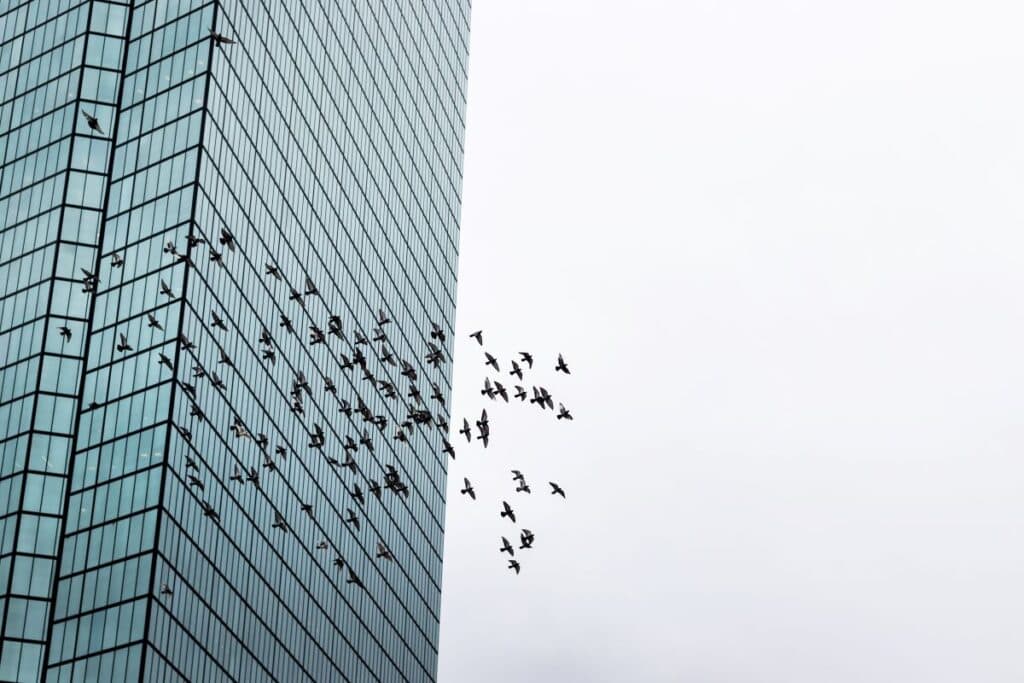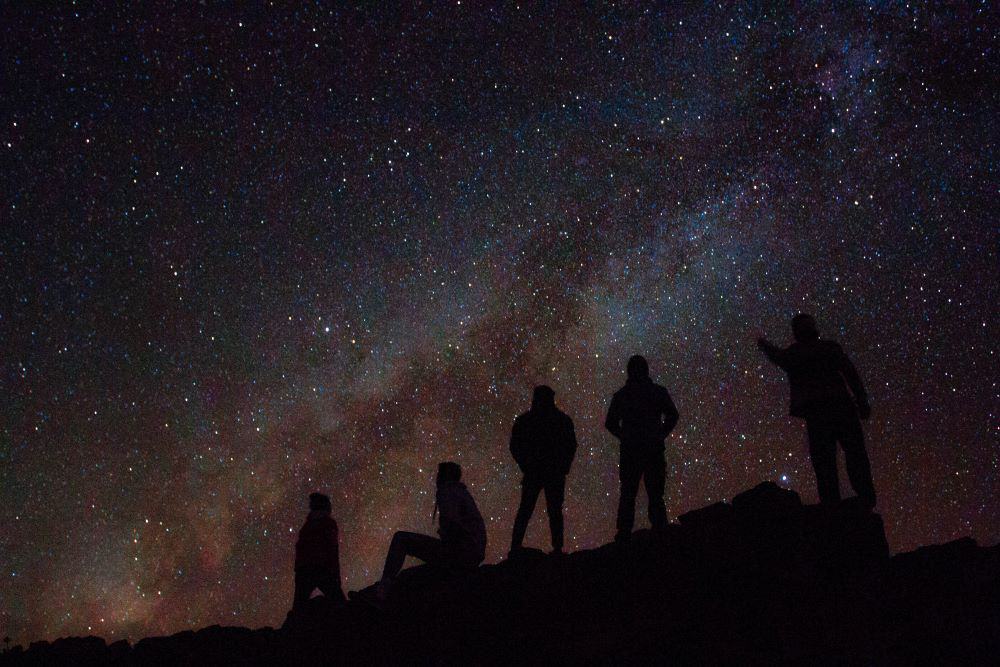
DLC Educational Series
In bustling urban centers and suburbs, commercial buildings stand as beacons of progress, their lights shining brightly against the night sky. While the lighting inside these buildings is essential for safety and functionality, it is a waste of energy and light if the illuminated spaces are unoccupied. The light emitted through building windows also contributes to a growing environmental challenge: light pollution.
Light pollution not only obscures our view of the stars but also has far-reaching implications for energy consumption, decarbonization, wildlife, and human health. Poor lighting and glare also reduces the overall aesthetic appeal of our buildings and spaces. This article delves into the intricacies of light pollution, its specific impact on outdoor environments, and the innovative solutions that the DesignLights Consortium offers to address this problem.
What is Light Pollution and Why Does It Matter?
In the simplest terms, light pollution is the brightening of the night sky due to excessive artificial light at night (ALAN).
For businesses and commercial properties, the repercussions of light pollution extend beyond environmental concerns. Excessive or poorly managed lighting can lead to increased energy consumption, translating to higher operational costs. Moreover, the glare from inadequately shielded lights can pose safety risks when drivers or pedestrians are temporarily blinded, potentially leading to accidents or making premises less secure.
The Growing Concern
The increasing prevalence of light pollution, growing at a staggering rate of 10% annually, is more than just a statistic—it’s a clarion call for the commercial sector to reevaluate their lighting strategies. As the nights become artificially brighter, commercial properties face a twofold challenge.
First, any excessive light beyond what is necessary wastes energy and money. While birds and moths may not directly impact operational costs, there are solutions that are both efficient and environmentally friendly. It’s not only about the immediate electricity bills; it’s also about the long-term investment in sustainable infrastructure.
Global Impact and Commercial Repercussions
The fact that 80% of the global population resides under light-polluted skies is a testament to the magnitude of this issue. For commercial entities, this isn’t just an environmental statistic, it’s a reflection of the collective impact of business operations worldwide. In today’s competitive market, a brand’s image is intricately tied to its environmental stewardship.
Poorly designed or excessive lighting can cast a literal and metaphorical shadow on a brand’s reputation. Potential clients or customers might be deterred, associating the brand with environmental neglect.
Light trespass from commercial buildings into residential spaces can have an impact on occupants’ rest and sleep. Disrupted circadian rhythms can lead to decreased productivity and potential health concerns.
Causes of Light Pollution and Its Impact

Light pollution, characterized by the excessive and misdirected artificial illumination of the night sky, has multifaceted origins. Among these, commercial buildings stand out due to their expansive lighting requirements, which, if not managed efficiently, can significantly contribute to the problem. Any light that falls out of the intended area is considered wasted energy. Over-lighting is often a misguided attempt at ensuring safety, but that should only apply when there are humans in the vicinity.
Sources and Contributors
The architectural marvels that are commercial buildings, with their vast facades and intricate designs, often require intricate lighting solutions. Buildings that operate round-the-clock, like hotels, 24/7 convenience stores, and late-night eateries, play a pivotal role in the light pollution narrative. But, the worst culprits are empty parking lots with lights fully on (not dimmed); empty buildings with interior lighting fully on and blinds open; and exterior retail environments with high light levels and lots of signage (e.g., gas stations, automobile sales lots with lights on at full output all night).
While the intention is often to ensure visibility and safety, outdated lighting systems, fixtures that cast light in all directions, and the absence of light shields or controls can result in excessive light spillage. This not only brightens the night sky unnecessarily but also represents a significant waste of energy, leading to increased operational costs. Poor lighting can also cause discomfort from glare or impair vision, which is a safety concern.
Human Activities and Urbanization
As cities expand and evolve, the transformation isn’t just in terms of infrastructure but also in the lifestyle and activities of its inhabitants. Shift work, late-night shopping, after-hours work culture, and the rise of nighttime entertainment venues have all contributed to the demand for more artificial lighting.
The rapid urbanization, marked by the sprouting of commercial centers and high-rise buildings, has inadvertently led to brighter city nights. Unfortunately, the awareness of sustainable lighting practices hasn’t kept pace with this urban growth, leading to increased light pollution.
Regulatory measures, too, are often lacking upper limits to illumination levels or are not stringent enough to curb the issue.
Impact of Outdoor Lighting
The impact of outdoor lighting in commercial spaces is multifaceted. It’s not just about visibility; it’s about creating an ambiance, highlighting architectural features, and ensuring security. However, the balance between functionality and unintended consequences is important.
Misaligned floodlights, overly bright lighting, lighting from glowing bright balls or acorn-type decorative light fixtures and even poorly placed landscape lights all contribute to light pollution.

Effects of Light Pollution: Wildlife, Ecosystems, and Health
Electric lighting, while important to urban progress and development, can negatively impact the intricate balance of our natural ecosystems and our own well-being.
The repercussions of light pollution extend beyond the mere obscuring of the night sky, impacting the lives of countless nocturnal and diurnal species and affecting our health in ways we’re only beginning to understand.
Effects on Wildlife and Ecosystems
Brightly lit commercial zones become hotspots of ecological disruption. Birds, often migrating at night, can be disoriented by intense lights, leading to fatal collisions with buildings or exhaustion from veering off their migratory paths. Insects, vital for pollination, are drawn to artificial lights, reducing their numbers and affecting plant reproduction. Migrating bats have to search harder for dark stopover points.
Nocturnal and diurnal creatures, from bats to birds to marine organisms to mammals, find their hunting, feeding, reproduction and sleeping patterns disrupted. As highlighted in a detailed study by the DesignLights Consortium, the intricate relationship between nighttime lighting and ecosystems highlights the need for sustainable lighting practices in commercial areas to protect our natural world.

Night Sky Preservation Efforts
The DesignLights Consortium is at the forefront of promoting products and practices that minimize light pollution, and ensuring commercial spaces are both efficient and environmentally friendly. The DLC created the LUNA technical requirements to distinguish high quality products that are designed to reduce both light pollution and energy usage.
LUNA seeks to reduce sky glow, light trespass, glare, and other adverse effects of artificial light at night to preserve our view of the night sky and minimize impacts on ecosystems. The technical requirements incorporate dimming best practices, shielding, light spectrum, sensors, and controls. DLC staffers are also working collaboratively on standards and specifications around glare and amber light so that LED products can be better characterized with these qualities.
Explore our free LUNA DLC Qualified Products List and start today to save energy and reduce light pollution in your buildings. For more detailed recommendations, see our resource Seven Strategies to Minimize Negative Impacts of Outdoor Light at Night.
© 2025 DesignLights Consortium. The DesignLights Consortium is a project of Efficiency Forward, Inc., a non-profit 501(c)3 organization. Privacy Policy Terms of Use